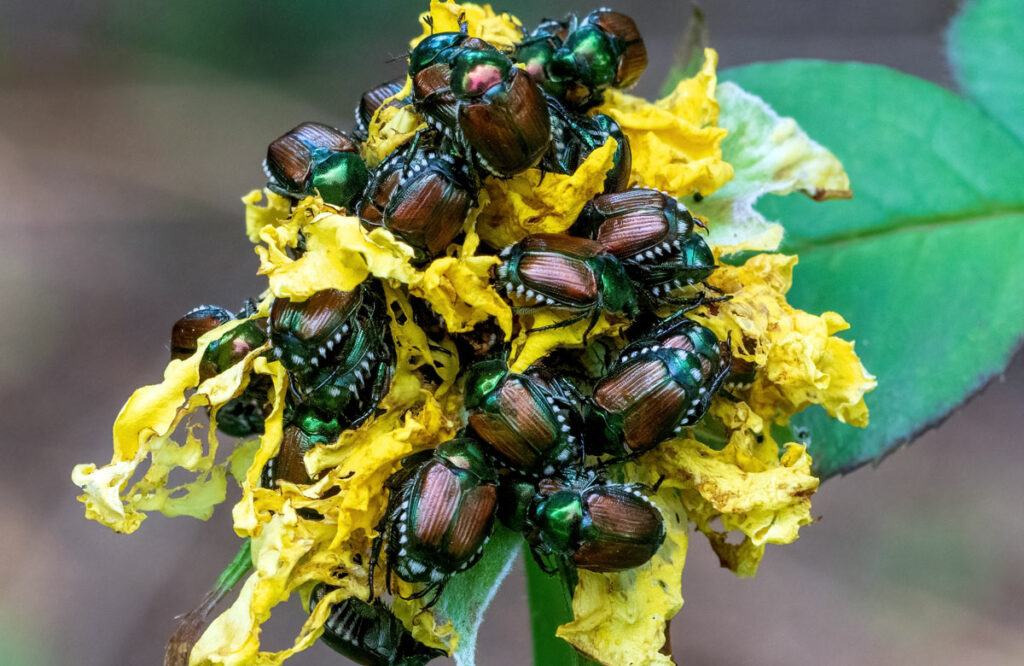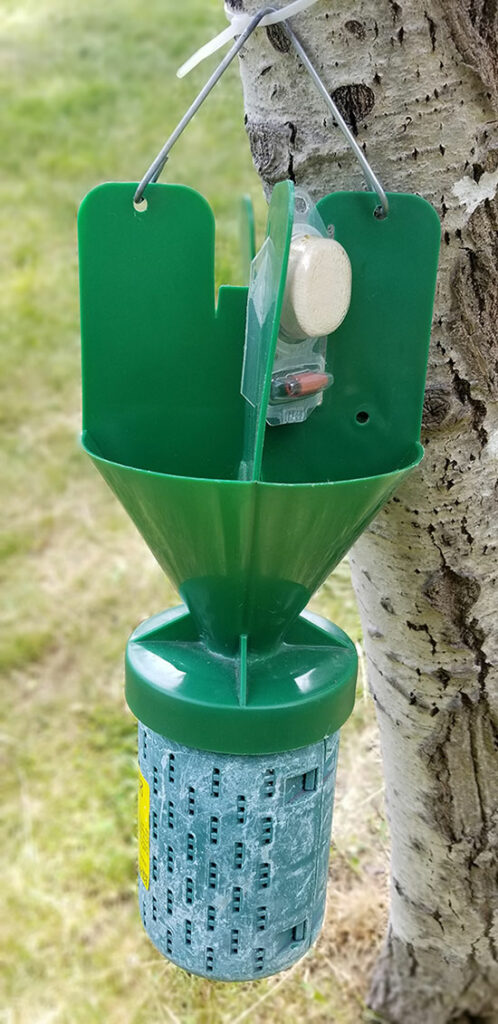
Japanese beetles, a notorious garden pest, can devour a wide variety of plants, leaving behind unsightly damage. As a gardener facing an invasion of these pesky creatures, it’s important to understand how to get rid of them and protect your garden from future infestations.
The first step to battling Japanese beetles is to properly identify these insects, as they’re not the only garden pests. They are easily recognizable by their metallic green body and copper-colored wings. Once you’ve confirmed the presence of Japanese beetles in your garden, you can implement various prevention strategies, trapping techniques, and chemical controls to help keep them at bay.
Physical removal, such as handpicking the beetles, can also be an effective approach, though it may be time-consuming. Long-term management is crucial to ensure that your garden remains free of Japanese beetles for years to come. By regularly monitoring and taking action, you can keep your garden healthy and thriving.
Key Takeaways
- Identify Japanese beetles by their metallic green body and copper-colored wings.
- Utilize prevention strategies, trapping techniques, and chemical controls to combat the infestation.
- Employ long-term management practices to maintain a Japanese beetle-free garden.
Identifying Japanese Beetles
Japanese beetles can be a nuisance in your garden, causing significant damage to your plants. In this section, we will discuss how to identify these pests through their physical characteristics, feeding habits, and the type of damage they cause.
Physical Characteristics
Japanese beetles are easy to spot due to their distinct appearance. They are approximately ⅜ inch long and ¼ inch wide. You’ll notice that they have a shiny, metallic green head and copper-colored wings. These beetles also possess white tufts of hair on the sides of their bodies.

Feeding Habits
These beetles are known for their voracious appetites, so it’s important to understand their feeding habits. They primarily feed on the leaves of your plants, causing a “skeletonizing” effect. This means they consume the green leaf material, leaving only veins behind. Japanese beetles prefer certain plants, such as roses, grapes, raspberries, and birch trees, but they aren’t picky and can attack over 300 types of plants.
Here are some key points on their feeding habits:
- They are active during daytime
- They prefer to feed in groups
- Foliar feeding starts from the top of the plants
Damage
Beyond just identifying Japanese beetles themselves, observing the damage they cause to your plants can help confirm their presence in your garden. As mentioned earlier, their feeding leaves a skeletonized pattern on your plant leaves. This damage can cause your plants to have stunted growth, reduced yield, and even die in severe cases.
In addition to plants, Japanese beetles can also damage your lawn. The beetle larvae, known as grubs, feed on the roots of grass, creating brown patches on your lawn.
By knowing how to identify Japanese beetles through their appearance, feeding habits, and the damage they cause, you can take the necessary steps to get rid of these pesky critters and protect your garden.
11 Quick Tips to Get Rid of Japanese Beetles
- Handpicking Patrol: The most direct approach! Early mornings and evenings are prime beetle-gathering times. Pop them into a jar of soapy water.
- Soapy Suds Attack: Mix a few tablespoons of dish soap with water in a spray bottle. Target the beetles directly – the soap clogs their breathing and eliminates them.
- Neem Oil Defense: This natural deterrent disrupts the beetles’ feeding and acts as a repellent. Apply early in the infestation when beetle numbers are lower.
- Garlic to the Rescue: Plant garlic near your prized plants. Beetles aren’t fond of the garlicky scent! Companion planting for the win!
- Milky Spore Solution: Milky spore is a natural bacterium that infects Japanese beetle grubs in your soil without harming other insects. It’s a long-term solution applied to your lawn.
- Geranium Repellent: Japanese beetles dislike the scent of geraniums. Plant these around your garden’s perimeter for a natural deterrent effect.
- Row Cover Rescue: Protect vulnerable young plants with lightweight row covers, allowing access to sun and water while keeping beetles at bay.
- Trap with Caution: While traps lure beetles, they may attract more than you bargained for. Only use if your infestation is severe, and keep traps away from your prized plants.
- Diatomaceous Earth: This natural powder is abrasive to beetles. Sprinkle it around the base of vulnerable plants.
- Early Bird Gets the Beetle: Beetles are sluggish in the cool mornings. Handpicking is easiest before they warm up and take flight.
- Lawn Love: Keep your lawn healthy. Japanese beetle grubs feast on turf roots, so a well-maintained lawn is less appealing to them.
Prevention Strategies
Attracting Natural Predators
One effective way to keep Japanese beetles at bay is by encouraging the presence of their natural predators in your garden. These beneficial insects and critters can help reduce the beetle population in a natural way, without using chemicals.
- Consider adding birdhouses, bat boxes, or toad houses to your garden. Birds, bats, and toads all feed on Japanese beetles and can significantly lower their numbers.
- Plant flowers like yarrow, dill, and fennel. These plants attract lacewings and ladybugs, which are natural enemies of Japanese beetles.
- Introduce parasitic nematodes to your soil. These tiny, soil-dwelling organisms feed on Japanese beetle grubs, helping to control future beetle populations.
Using Companion Planting
Companion planting is another excellent strategy to deter Japanese beetles. Some plants release chemicals that repel these pests or serve as a natural barrier. Make sure to incorporate the following plants into your garden:
- Marigolds – These bright, colorful flowers release a scent that repulses Japanese beetles.
- Catnip – The strong aroma of catnip is known to keep the beetles away as well.
- Garlic and chives – These aromatic plants can help mask the scent of the plants that Japanese beetles find attractive, making it harder for them to locate their favored food sources.

In addition to these prevention strategies, keep a close eye on your garden for early signs of infestation. Promptly removing and disposing of any beetles you find can help minimize their impact on your plants.
Trapping Techniques
Commercial Pheromone Traps

One effective way to get rid of Japanese beetles is by using commercial pheromone traps. These traps use synthetic sex pheromones to attract the beetles, luring them away from your plants.
To make the most out of these traps, follow these steps:
- Place the traps at least 10 feet away from the plants you want to protect.
- Hang them about 3 feet above the ground on trees or posts.
- Empty and clean the traps regularly to prevent overflow.
Remember, these traps are only a part of your pest control strategy and should be combined with other methods for the best results.
DIY Traps
If you prefer to go the DIY route, you can create simple, homemade traps. Here’s a quick recipe:
Materials:
- Plastic milk jug (gallon-sized) or similar container
- String or wire for hanging
- Bait (mashed fruit, e.g., overripe bananas or peaches)
Instructions:
- Cut a few holes around the top part of the milk jug, large enough for the beetles to enter.
- Fill the jug with a mixture of mashed fruit (enough to cover the bottom) and water. The fruit will act as bait, attracting the beetles.
- Hang the trap in an area where you’ve noticed beetle activity, but again, keep it at least 10 feet away from your plants.
To maximize trapping efficiency, make sure to:
- Check the traps daily, emptying and cleaning them as needed.
- Replace the bait with fresh fruit when it loses its aroma or becomes less effective.
With these trapping techniques, you should see a noticeable reduction in the Japanese beetle population in your garden. Just remember to be vigilant and consistent in your efforts for the best outcomes.
Chemical Control
Insecticides
In order to protect your garden from Japanese beetles, you can use insecticides as an effective method. When choosing an insecticide, look for products containing active ingredients like carbaryl, imidacloprid, or permethrin. These can be found in various forms including liquid concentrates, granules, or ready-to-use sprays.
- Apply the insecticides according to the manufacturer’s instructions.
- Focus on the infested areas and the beetles’ feeding sites.
- Treat your garden in the early morning or late afternoon, when Japanese beetles are most active.
Remember, however, that using chemical insecticides may also affect beneficial insects in your garden. Consider this when deciding if insecticides are the best solution for you.
Organic Solutions

If you prefer a more environmentally-friendly approach, there are organic solutions you can use to control Japanese beetles:
- Neem oil: Derived from the Neem tree, this natural insecticide can be applied to your plants to repel and kill the beetles.
- Pyrethrin: A natural insecticide found in chrysanthemum flowers, pyrethrin works well when sprayed on infested plants.
To enhance the effectiveness of these organic solutions, consider the following tips:
- Target new infestations and smaller beetle populations.
- Combine physical removal methods with organic solutions.
- Maintain a consistent spraying schedule.
Using chemical control methods can be an effective way to manage Japanese beetles in your garden. By selecting the right insecticides or organic solutions, you can safeguard your plants and enjoy a thriving, beetle-free garden.
Physical Removal
Japanese beetles can be a real nuisance in your garden, but fortunately there are several methods to physically remove them. First, let’s go over a simple and eco-friendly technique: handpicking. Although it might be time-consuming, handpicking allows you to remove the beetles without causing harm to your plants or surrounding environment.
To handpick Japanese beetles:
- Do this early in the morning when they are less active.
- Wear gloves to protect your hands.
- Gently shake the plant to dislodge the beetles and catch them with a bowl of soapy water underneath. This will kill the beetles without any harmful chemicals.
Another effective method is using a trap. There are various types of traps available on the market, but most use a pheromone or floral scent to lure the beetles. When setting up a trap, make sure to place it at least 25 feet away from the plants you want to protect so that you don’t inadvertently attract more beetles to your garden.
To set up a trap:
- Follow the manufacturer’s instructions for assembly.
- Place the trap in an area with known beetle activity.
- Check and empty the trap regularly to prevent the smell of dead beetles attracting more.
Finally, consider using physical barriers like netting or row covers. These materials can prevent the beetles from reaching your plants while allowing sunlight and air to pass through, keeping your plants healthy.

To install netting or row covers:
- Choose a mesh size that prevents the beetles from passing through but allows light and air circulation.
- Secure the netting or cover with stakes, making sure it’s taut and covers the entire area you want to protect.
- Allow some room for your plants to grow and ensure the cover edges reach the ground to prevent beetles from crawling underneath.
By using a combination of these physical removal techniques, you’ll be well on your way to controlling the Japanese beetle population in your garden and keeping your plants safe from damage.
Long-Term Management
To get rid of Japanese beetles in your garden, it’s important to have a long-term management plan in place. This will help to reduce their population and protect your plants from damage.
One of the most effective methods to control Japanese beetles is by introducing natural predators into your garden. Beneficial insects such as ladybugs, lacewings, and parasitic wasps can help keep their numbers down. Additionally, birds like starlings and robins are known to be fond of eating Japanese beetles’ larvae. Attract these creatures to your yard by installing bird feeders and bird houses, and planting flowers that attract beneficial insects.
Another way to control Japanese beetles is through cultural practices that make the environment less favorable for them. Removing diseased or damaged plants, maintaining proper soil conditions, and practicing good sanitation in your garden can all help reduce the likelihood of an infestation. Be sure to use mulch, as it helps to maintain moisture in the soil and promotes aeration, discouraging beetles from laying eggs.
Consider the use of pheromone traps as a means of controlling adult beetles. These devices attract and trap beetles by emitting a scent that mimics their natural pheromones. While they can be effective in reducing beetle numbers, it’s important to place them correctly – at least 30 feet away from your garden. This will prevent the traps from attracting more beetles to your plants.
Incorporating resistant plant varieties in your garden can also minimize damage caused by Japanese beetles. Choose plants that are less appealing to the pests, such as boxwood, dogwood, or magnolia. Research the best options for your region and space, and incorporate these resistant plants into your garden design.
Lastly, consider using chemical controls only when necessary, as a last resort. Before opting for pesticides, consult with a local expert who can advise on the most appropriate and least harmful products for your garden. Remember to always follow the directions on the label and apply these chemicals with care to avoid harm to beneficial insects and other living organisms.













